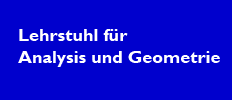|
|
|
Seminar: Graphs and Surfaces
| Titel: |
Seminar über Graphs and Surfaces |
| Dozent(in): |
Prof. Dr. Katrin Wendland, Dr. Igor Mencattini |
| Termin: |
Di. 14:00-16:30 (T 2002) |
| Gebäude/Raum: |
T 2002 (Physik) |
| Ansprechpartner: |
Dr. Igor Mencattini |
Inhalt der Lehrveranstaltung:
During the last thirty years, the interaction between physics and mathematics has been particularly fruitful. In particular, most of the achievements in the realm of low-dimensional topology have been obtained using ideas and tools coming from (quantum) field theory. Some classical and difficult problems in enumerative geometry have been attacked using such techniques. In this respect, the proof given by Maxim Kontsevich of Witten's conjecture on the intersection theory for the moduli spaces of curves is an emblematic example.
A more down to earth example of this spectacular interaction can be introduced as follows.
It is well known from elementary topology that we can produce closed and orientable surfaces by gluing sides of polygons in pairs: consider a $2n$-gon, give it an orientation, and split its sides in all possible ways. For any such splitting, glue together the sides belonging to the same pair, always respecting the rule "end to the head". The result of this procedure will be an orientable closed surface. It is not too difficult to show that there are exactly $(2n-1)!!$ different ways to glue the pairs of edges. It is a natural question to ask how many surfaces of a given genus $g$ we can produce with the previous procedure (an easier task would be to find the maximum genus of a surface we can obtain from an $n$-gon). This is a typical combinatorial problem, whose complete solution requires to find a generating function. This problem has been solved, for general genus, by John Harer and Don Zagier ("The Euler characteristic of the moduli space of curves", Inv. Math. 86 (1986), 457-485), and it takes the following form. If $e_g(n)$ is the number of surfaces of genus $g$ that we obtain from a polygon with $n$ sides, then: $$e_g(n)={frac{4n-2}{n+1}}e_g(n-1)+{frac{(n-1)(2n-1)(2n-3)}{n+1}}e_{g-1}(n-2)$$ with the conditions $e_g(0)=1$ if $g=0$ and $0$ otherwise. The proof of the previous formula was obtained using techniques of integration over the space of hermitian matrices. Those techniques are very well known in physics as being part of what is called random matrix theory, which, very roughly speaking, can be though of as the simplest example of quantum field theory. The Harer-Zagier result is not only important per se, but it is the key step for the calculation of what is called the (virtual) Euler characteristic of the moduli space of complex curves of a given genus $g$.
One more time, the moral we can learn is the following: techniques borrowed from quantum field theory can been used to attack (and in some cases) to solve combinatorial problems.
Following this suggestion, the goal of the seminar will be first to learn some of those techniques and then to see some of those (quite remarkable) applications.
Literatur zur Lehrveranstaltung:
Lando, S.K. and Zvonkin, A.K Graphs on Surfaces and Their Applications, EMS Low-Dimensional Topology II, Springer Verlag, (2004).
Suggested reading for 1) Quantum field theory techniques in graphical enumeration: Bessis, D. Itzykson, C. and Zuber, J.P. "Quantum field theory tecniques in graphical enumeration", Adv. in Appl. Math. 1 (2), 109-157, (1980)
suggested reading for 2) Applications of part 1) to the topology of moduli space of complex curves:
(a) Harer, J. and Zagier, D. "The Euler characteristic of the moduli space of curves", Inv. Math. 86 (1986), 457-485
(b) Penner, R.C. "Perturbative series and the moduli space of Riemann surfaces", Jour.Diff.Geo. 27 (1988), 35-83
A general reference for the theory of moduli of complex curves is:
Harris, J. and Morrison, I. Moduli of Curves, GTM 187, Springer Verlag (1998)
weitere Informationen zu der Lehrveranstaltung:
| empfohlenes Studiensemester der Lehrveranstaltung: |
ab dem 5. Semester |
| Fachrichtung Lehrveranstaltung: |
Mathematik |
| Nummer der Lehrveranstaltung: |
06086 |
| Dauer der Lehrveranstaltung: |
2 SWS |
| Typ der Lehrveranstaltung: |
S - Seminar |
| Leistungspunkte: |
6 LP für Vortrag |
| Bereich: |
Geometrie |
| Semester: |
WS 2006/07 |
|



